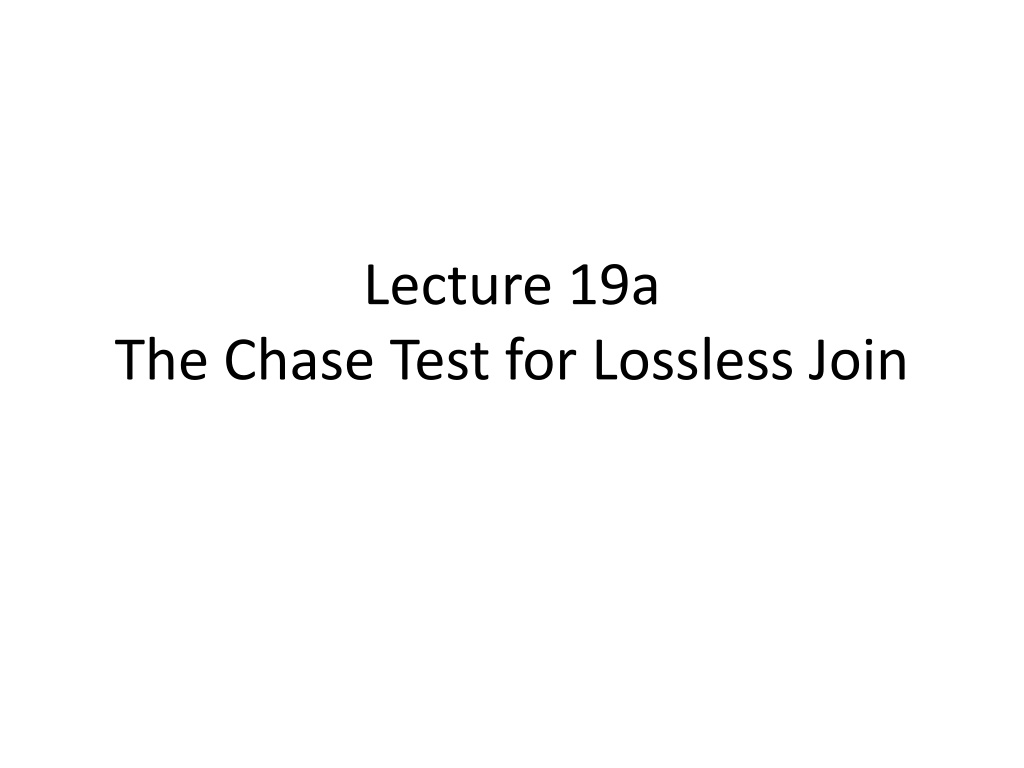
Understanding Lossless Join and the Chase Test
Learn about lossless decomposition, the Chase Test for lossless join, and the process of proving tuple equivalence using functional dependencies. Follow an example to understand how to apply the Chase Test and ensure data integrity in database management.
Uploaded on | 0 Views
Download Presentation

Please find below an Image/Link to download the presentation.
The content on the website is provided AS IS for your information and personal use only. It may not be sold, licensed, or shared on other websites without obtaining consent from the author. If you encounter any issues during the download, it is possible that the publisher has removed the file from their server.
You are allowed to download the files provided on this website for personal or commercial use, subject to the condition that they are used lawfully. All files are the property of their respective owners.
The content on the website is provided AS IS for your information and personal use only. It may not be sold, licensed, or shared on other websites without obtaining consent from the author.
E N D
Presentation Transcript
Lecture 19a The Chase Test for Lossless Join
Lossless Decomposition We say if a decomposition is lossless if the original relation can be recovered completely by natural joining the decomposed relations. Three important facts to remember: The natural join is associative. That is, the order of the relation join does not mater. Any tuple t in R is surely in the joined decomposed relations. If we can prove any tuple t in joined relation R1u R2u u Rkis also in R, we have a 1-1 mapping between R and re-joined relation, thus a lossless decomposition.
Chase Test The chase test is an organized way to see whether a tuple t in joined relation R1u R2u u Rkcan be proved using FDs also to be a tuple in R. We will show through an example how the process works.
Notations Assume R has attributes A, B, We use a, b, for the components of t. For ti, we use the same letter as in the components that are in Si, but we subscript the letter with i if the component is not in i. The example in next slide will clarify the notation.
Example Suppose we have relation R(A,B,C,D) and FD s A B, B C, CD A. Assume we have decomposed R into relations with sets of attributes S1={A,D}, S2={A,C}, and S3={B,C,D}. Then the tableau (re-joined) for this decomposition looks as follows. A B C D a a b1 b2 c1 c d d2 a3 b c d Note: 1. Attribute letters with subscript mean that they are arbitrary values. 2. Attributes with subscripts are free values that eventually will be proved not.
Chasing 0 Our goal is to prove those rows with subscripted attributes are really in original R. We chase the tableau by applying FDs repeatedly until the relation becomes R. In the next a few slides, we will see how the tableau evolves when FDs are applied
Chase 1 Because the first two rows agree on attribute A, they must also agree on attribute B by the FD {A B}, so the tableau evolves into A B C D a b1 c1 d a b1 b c c d2 d a3 The red colored subscript indicates the change, in this case from b2 to b1.
Chase 2 Because the first two rows now agree on attribute B, they must also agree on attribute C by the FD {B C}, thus c and c1 must be the same. So the tableau evolves into A B C D a b1 c d a b1 c d2 a3 b c d The red colored subscript indicates the change, in this case c1 to c.
Chase 3 We know {CD A}, checking row 1 and row 3, a and a3 must agree. So the tableau evolves into A B C D a a b1 b1 c c d d2 a b c d The red colored subscript indicates the change, in this case a3 to a. At this point, we see that last row becomes (a,b,c,d) which is the original R. Other rows must agree as well.
Lets revisit some early examples Name Fred Fred Joe Joe SSN 123-45-6789 123-45-6789 987-65-4321 987-65-4321 PhoneNumber 206-555-1234 206-555-6543 908-555-2121 908-555-1234 City Seattle Seattle Madison Madison {SSN} {Name,City} This FD is bad because it is not a superkey, {SSN} can t determine {PhoneNumber} Not in BCNF 10
R is decomposed into R1 and R2 Name SSN Fred Joe City Seattle Madison {SSN} {Name,City} 123-45-6789 987-65-4321 This FD is now good because it is the key SSN 123-45-6789 123-45-6789 987-65-4321 987-65-4321 PhoneNumber 206-555-1234 206-555-6543 908-555-2121 908-555-1234 Now in BCNF! R can be recovered by joining R1 and R2! 11
